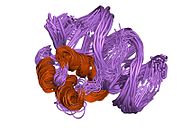Biology:PITX3
From HandWiki
Short description: Protein-coding gene
 Generic protein structure example |
Pituitary homeobox 3 is a protein that in humans is encoded by the PITX3 gene.[1][2]
Function
This gene encodes a member of the RIEG/PITX homeobox family, which is in the bicoid class of homeodomain proteins. Members of this family act as transcription factors. This protein is involved in lens formation during eye development,[2] and the specification and terminal differentiation of mesencephalic dopamine neurons in the substantia nigra compacta that are lost in Parkinson's disease.[3]
Clinical significance
Mutations of this gene have been associated with anterior segment mesenchymal dysgenesis (ASMD) and congenital cataracts.[2]
References
- ↑ "A novel homeobox gene PITX3 is mutated in families with autosomal-dominant cataracts and ASMD". Nature Genetics 19 (2): 167–70. June 1998. doi:10.1038/527. PMID 9620774.
- ↑ 2.0 2.1 2.2 "Entrez Gene: PITX3 paired-like homeodomain transcription factor 3". https://www.ncbi.nlm.nih.gov/sites/entrez?Db=gene&Cmd=ShowDetailView&TermToSearch=5309.
- ↑ "Early developmental failure of substantia nigra dopamine neurons in mice lacking the homeodomain gene Pitx3". Development 131 (5): 1145–55. March 2004. doi:10.1242/dev.01022. PMID 14973278.
Further reading
- "The role of Pitx3 in survival of midbrain dopaminergic neurons". Parkinson's Disease and Related Disorders. Journal of Neural Transmission. Supplementa. 70. 2006. 57–60. doi:10.1007/978-3-211-45295-0_10. ISBN 978-3-211-28927-3.
- "Variable expressivity of autosomal dominant anterior segment mesenchymal dysgenesis in six generations". American Journal of Ophthalmology 93 (1): 57–70. January 1982. doi:10.1016/0002-9394(82)90700-0. PMID 6801987.
- "Recurrent 17 bp duplication in PITX3 is primarily associated with posterior polar cataract (CPP4)". Journal of Medical Genetics 41 (8): e109. August 2004. doi:10.1136/jmg.2004.020289. PMID 15286169.
- "Posterior polar cataract: genetic analysis of a large family". Ophthalmic Genetics 26 (3): 125–30. September 2005. doi:10.1080/13816810500229124. PMID 16272057.
- "Cooperative transcription activation by Nurr1 and Pitx3 induces embryonic stem cell maturation to the midbrain dopamine neuron phenotype". Proceedings of the National Academy of Sciences of the United States of America 103 (8): 2874–9. February 2006. doi:10.1073/pnas.0511153103. PMID 16477036. Bibcode: 2006PNAS..103.2874M.
- "Heterozygous and homozygous mutations in PITX3 in a large Lebanese family with posterior polar cataracts and neurodevelopmental abnormalities". Investigative Ophthalmology & Visual Science 47 (4): 1274–80. April 2006. doi:10.1167/iovs.05-1095. PMID 16565358.
- "The PITX3 gene in posterior polar congenital cataract in Australia". Molecular Vision 12: 367–71. 2006. PMID 16636655.
- "Functional analysis of human mutations in homeodomain transcription factor PITX3". BMC Molecular Biology 8: 84. 2007. doi:10.1186/1471-2199-8-84. PMID 17888164.
External links
- PITX3+protein,+human at the US National Library of Medicine Medical Subject Headings (MeSH)
This article incorporates text from the United States National Library of Medicine, which is in the public domain.
 |


